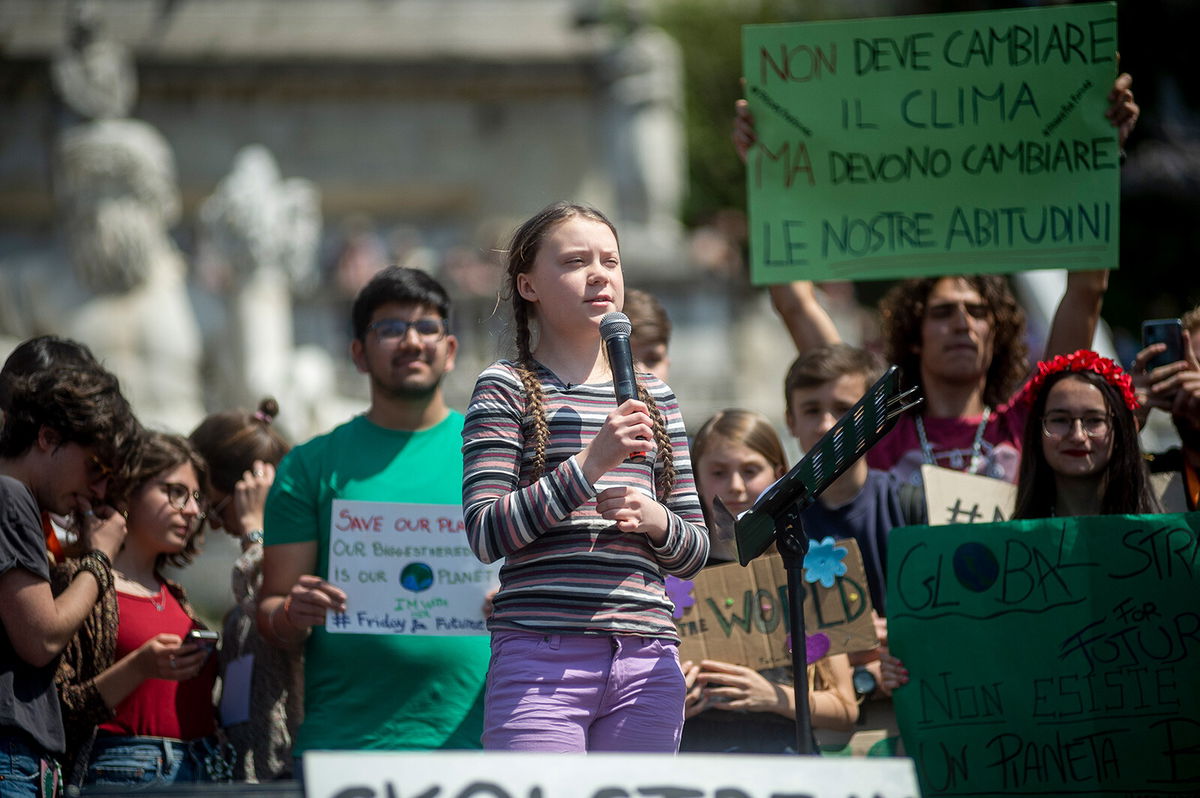Yes, your kid can change the world. Here’s how

Swedish activist Greta Thunberg urges action to combat the climate crisis in April 2019 in Rome.
By Elissa Strauss, CNN
It has become harder for children to experience childhood as a time of blissful ignorance about the state of our planet. Climate change, racism, discrimination, poverty and gun violence are affecting their daily lives, giving them plenty to be upset about it and often inspiring them to fight for change. Role models such as Greta Thunberg and Malala Yousafzai prove that sometimes when kids take action, adults listen.
Aspiring Thunbergs and Yousafzais tend to be drawn to online activism and social media, the destination for many young people curious about causes and eager to express themselves. It can be a great way to spark interest, but it’s not always the best way to effect real change. For that to happen, kids need to understand the power of quieter, slower and historically effective approaches to activism, says Gal Beckerman — those that tend to take place off of social media.
In his new book, “The Quiet Before: On the Unexpected Origins of Radical Ideals,” Beckerman examines social movements throughout history, chronicling how effective revolutions tend to start with intimate conversation and deliberation about issues, not shouting in the streets or, today’s version, online. His lessons are relevant to young activists, including the many who are fired up by Earth Day to heal and protect our planet.
CNN spoke with Beckerman, a father of two, about why children need to understand the quiet and slow side of activism. He explains why dinnertime or drive-time talk, or conversations in small groups, are so important in helping kids understand the complexity of issues and perfect the art of speaking and listening. He also talks about why a visit to a soup kitchen or a day spent registering voters will teach them more about changing the world than TikTok.
This conversation has been edited and condensed for clarity.
CNN: Your kid reads or hears about a cause at school and is excited about it. What could a parent encourage them to do next?
Gal Beckerman: It’s wonderful when kids gain an interest in a cause that impassions them and gets them excited, and if that comes from social media or something they are seeing online, that’s great. The role of a parent can be to help them figure out what to do with it.
I suggest that parents direct kids toward local activism connected to whatever cause they care about, places where they will feel that their growing sense of commitment to a cause can be attached to concrete action. This could be volunteering at a soup kitchen or helping plan a protest.
CNN: What could we say to them about their online activism?
Beckerman: It’s important for parents to make a distinction between expressing solidarity with causes you believe in and doing something to effect change. You don’t want kids to think that all they have to do is post a hashtag of something they agree with or post a picture at a protest to be an effective activist.
It doesn’t take much dedication to commit to climate change or ending racism on social media, compared with the hard work of committing to doing something about it in real life. Help them think: “What is the goal? What is my goal? And what am I doing to achieve the goal?” It’s OK if their goal is small.
Parents also need to manage the expectations of kids who might not understand that real change is slow. To go on a Saturday to work at a soup kitchen or register people to vote might feel like a small boring activity. It is the parents’ role to connect that to the bigger, more exciting things they see on TikTok.
CNN: Effective activism can be boring, right?
Beckerman: It’s important for kids to understand this because it is often out of the hard work of bringing a cause to life, walking the street to collect signatures, organizing community forums, contacting local politicians again and again, that your sense of commitment and solidarity grows. If something is easy, it is often forgettable.
A problem like climate change demands fresh thinking as well as careful and sometimes painstaking work. We do our kids a disservice by not teaching them this.
CNN: Your book demonstrates the value of cultivating activism in intimate places — as opposed to in public or on social media.
Beckerman: It’s helpful to be able to gather with a small group of people, in person or online, and share ideas and not worry about being shamed for something you proposed. You need a space where you can do more than just exclaim how you feel but where you can also have a conversation about it and build on one another’s ideas. This lets you take a step back and see which tools exist and figure out which ones are the right ones to pick up.
For older kids and teens, apps like Signal, private groups on Facebook, or email chains can create this intimacy online. In these quiet spaces, the concern is not about going viral but to keep the conversations going.
To be clear, it can’t just be quiet. There is a role to play for protesting and all the passion that comes along with chanting a slogan in the streets. But what kids do need to understand is that this isn’t enough. They need space to dream and argue and whittle that passion into a sharper point.
CNN: Can you give me an example from history of a time when slow, persistent activism paid off?
Beckerman: Most social movements in history were slow builds, if only because the tools we have today that allow us to mobilize so quickly and with such numbers didn’t exist.
But to take a concrete example, you can look at Chartism, a movement that began in England in the 1830s. Working-class people at the time did not have the right to vote, so they came up with the idea of petitioning Parliament for that right. It was a long struggle, and instead of social media they had the pen-and-paper petition, which they took around the country, starting up conversations and trying to convince people to sign. That first petition, delivered to Parliament in 1839, had 1.3 million petitions and was on a scroll that stretched 3 miles long. They failed in that first effort, but the petitions kept coming, each one widening their constituency, until three decades later they finally won political representation.
CNN: When has making big statements online not brought about much change?
Beckerman: The Arab Spring is a great example of this. It’s not so much that the expressions of outrage that started on social media didn’t bring change — in Egypt it got hundreds of thousands of people to (Cairo’s) Tahrir Square, where their physical presence brought down a dictator. The problem was the day after, when those activists in the square then needed to transform themselves into a political opposition with a clear ideology and set of goals and a method for working together. Social media didn’t provide them the tools they needed to do this building. Instead, it undermined them by making them think the only kind of activism that mattered was loud and attention-grabbing. As a result, they were never able to pose a real challenge to the more entrenched forces in the country.
CNN: In your book, you refer to philosopher Hannah Arendt talking about the importance of a physical table to “draw individuals into deliberation, their faces turned toward one another.” Can that start with the family table?
Beckerman: One of the positive sides to Covid for my family is that we have dinner together every night. Our kids come to us and bring us whatever they experienced that day, and we talk about it.
Sometimes they talk about feeling upset by the homeless people they see on their way home. We ask them: “Why do you think that is? What do you think led them to that situation?” We also help them think about the challenges the city faces in dealing with the situation.
The dinner table becomes this space where we can talk over these things, and more importantly, it is a place where they can practice having a conversation. Not just about homelessness but about anything. There is a skill and art to the kind of exchanges that happen around the table, which is different from the exclamations or declarations they will hear online. They are learning to listen, to go back and forth, to take somebody’s ideas and improve on them. This is all great for a kid to practice under the safety net of their family.
The-CNN-Wire
™ & © 2022 Cable News Network, Inc., a WarnerMedia Company. All rights reserved.
Elissa Strauss covers the culture and politics of parenthood. Her book on the radical power of parenting and caregiving will be published in 2023.


